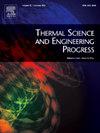高热流密度轨道表面喷雾冷却换热性能实验研究
IF 5.1
3区 工程技术
Q2 ENERGY & FUELS
引用次数: 0
摘要
缺乏最佳喷雾冷却参数的选择原则,将不利于高热流密度电磁导轨的有效热管理。本文对高热流密度垂直钢轨表面喷雾冷却的换热特性和冷却效果进行了实验研究,设计并搭建了实验系统,对影响钢轨冷却效果的主要因素进行了实验研究。结果表明:随着喷淋距离的增加,临界热流密度(CHF)、平均热流密度(AHF)和综合换热系数(IHTC)均呈现先增大后减小的趋势,轨面平均温度逐渐降低;当喷淋深度增加到25 cm时,CHF、AHF和IHTC分别达到最大值241.69 W/cm2、44.10 W/(cm2 K)和14007.02 W/(m2 K),而轨面平均温度(AST)达到最小值55.77℃。随着喷射角的增大,CHF、AHF和IHTC均呈现先增大后减小的趋势,而rail的AST则呈现先减小后增大的趋势。喷射角为0°时,冷却效果最佳。随着喷嘴入口冷却水压力的增大,CHF、AHF和IHTC均呈逐渐增大的趋势,而导轨AST呈逐渐减小的趋势。当冷却水压力增加到0.5 MPa时,CHF、AHF和IHTC达到最大值,AST达到最低值。研究结果对提高高热流密度钢轨表面的喷雾冷却效果具有积极的指导意义。本文章由计算机程序翻译,如有差异,请以英文原文为准。
Experimental study on heat transfer performance of spray cooling on high heat flux rail surface
Lack of the principle of selecting the best spray cooling parameters will be detrimental to the effective thermal management of the high heat flux electromagnetic rail. This paper conducted experimental study on the heat transfer characteristics and cooling effect of spray cooling on a high heat flux vertical rail surface, an experimental system was designed and built, and the main influencing factors on the cooling effect of the rail were experimentally studied. the results showed that with the increasing spray distance, the critical heat flux (CHF), average heat flux (AHF) and integrated heat transfer coefficient (IHTC) all increased first and then decreased, while the average temperature of rail surface gradually decreased. When the spray increased to 25 cm, the CHF, AHF and IHTC reached the maximum value of 241.69 W/cm2, 44.10 W/(cm2 K) and 14007.02 W/(m2 K), while the average surface temperature (AST) of rail reached the minimum value of 55.77 ℃. With the increase of spray angle, the CHF, AHF and IHTC shown a trend of first increasing and then decreasing, while the AST of rail shown a trend of first decreasing and then increasing. The best cooling effect can be obtained at the spray angle of 0°. As the cooling water pressure at the nozzle inlet increased, the CHF, AHF and IHTC all shown a gradually increasing trend, while the AST of rail shown a gradually decreasing trend. When the cooling water pressure increased to 0.5 MPa, the CHF, AHF and IHTC reached the maximum value, while the AST reached the lowest value. The results have a positive guiding significance for improving the spray cooling effect of the high heat flux rail surface.
求助全文
通过发布文献求助,成功后即可免费获取论文全文。
去求助
来源期刊

Thermal Science and Engineering Progress
Chemical Engineering-Fluid Flow and Transfer Processes
CiteScore
7.20
自引率
10.40%
发文量
327
审稿时长
41 days
期刊介绍:
Thermal Science and Engineering Progress (TSEP) publishes original, high-quality research articles that span activities ranging from fundamental scientific research and discussion of the more controversial thermodynamic theories, to developments in thermal engineering that are in many instances examples of the way scientists and engineers are addressing the challenges facing a growing population – smart cities and global warming – maximising thermodynamic efficiencies and minimising all heat losses. It is intended that these will be of current relevance and interest to industry, academia and other practitioners. It is evident that many specialised journals in thermal and, to some extent, in fluid disciplines tend to focus on topics that can be classified as fundamental in nature, or are ‘applied’ and near-market. Thermal Science and Engineering Progress will bridge the gap between these two areas, allowing authors to make an easy choice, should they or a journal editor feel that their papers are ‘out of scope’ when considering other journals. The range of topics covered by Thermal Science and Engineering Progress addresses the rapid rate of development being made in thermal transfer processes as they affect traditional fields, and important growth in the topical research areas of aerospace, thermal biological and medical systems, electronics and nano-technologies, renewable energy systems, food production (including agriculture), and the need to minimise man-made thermal impacts on climate change. Review articles on appropriate topics for TSEP are encouraged, although until TSEP is fully established, these will be limited in number. Before submitting such articles, please contact one of the Editors, or a member of the Editorial Advisory Board with an outline of your proposal and your expertise in the area of your review.
 求助内容:
求助内容: 应助结果提醒方式:
应助结果提醒方式:


